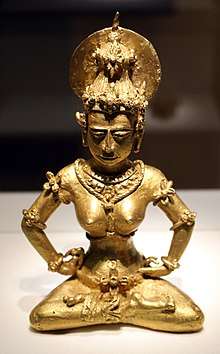Golden Tara
| Part of a series on |
| Vajrayana Buddhism |
|---|
 |
|
Traditions Historical traditions:
New branches:
|
|
History |
|
Pursuit |
|
Practices |
|
Festivals |
|
Ordination and transmission |
|
|
The Golden Tara is a 1.79 kilogram, 21 carat Majapahit period gold image of a Hindu goddess discovered in Esperanza, Agusan in 1918. When it was purchased by the Field Museum of Chicago, they renamed it as Agusan Gold Image, though this name is rejected by scholars in the Philippines.
H. Otley Beyer believed that the image was that of a Hindu Sivaite goddess, but with the religiously important hand signals improperly copied by local workmen. Thus it suggests that Hinduism was already in the Philippines before Ferdinand Magellan arrived, but also suggests that the early Filipinos had an imperfect version of Hinduism which they got from the Majapahit.
A study of this image was made by Dr. F. D. K. Bosch, of Batavia, in 1920, who came to the conclusion that it was made by local workmen in Mindanao, copying a Nganjuk images of the early Majapahit period - except that the local artist overlooked the distinguishing attributes held in the hand. It probably had some connection with the Javanese miners who are known to have been mining gold in the Agusan-Surigao area in the middle or late 14th century. The image is apparently that of a Sivaite goddess, and fits in well with the name "Butuan" (signifying "phallus").
After its discovery in 1918 by a Manobo woman named Bilay Campos, it was stolen while being safeguarded inside a hidden chest inside her traditional Manobo house. Before being stolen, the tribe of Manobos, where Campos belonged to, viewed the Golden Tara as a diwata, a nature spirit deemed to protect the vastness of their ancestral domain's rainforests and waterways. Later on, the artifact would land in the possession of the area's governor for unknown links. The artifact would later be sold in a multinational company, where the governor was indebted to with a large sum of money. For unknown reasons, the artifact eventually landed for auction, prompting H. Otley Beyer to demand the Philippine government to buy the artifact for the sake of the National Museum of the Philippines and the Philippine nation. However, during that time, the country was in deep financial constraint, and was unable to buy the artifact. The Golden Tara was purchased by the Field Museum of Natural History of Chicago, Illinois in 1922 for a sum of approximately 4,000 pesos. According to the Field Museum, the artifact was purchased to save it from being melted at the time because the Philippines was having a hard time with its finances, which may have led to the minting of the artifact to aid in the country's financial losses. The purchase was funded through a campaign in Chicago to buy the artifact, with the aid of the American government, which at the time was also the colonial government in the Philippines. By 2010, the artifact's price has risen to approximately 1.5 million Philippine pesos.

.jpg)
The artifact has been a source of conflict between Filipinos and Americans for many years as many Filipino scholars have demanded for the return of the Golden Tara, as it is a national treasure of the country, unreported during the time of discovery, and sold to Americans during a great financial loss to the country - the very reason why the Philippine government at the time was not able to buy the artifact when it was auctioned. Scholars have argued that if the reason why the Field Museum took the artifact was because they fear that it may have been melted down, why has the Field Museum not returned or at least let the Philippines buy the artifact back since no group in the Philippines advocates for its melting anymore. On top of the argument is the cunning way the artifact was bought by an American museum during a time when the Philippines was in financial constraint under the colonial government of America. One of the major protesters for the return of the Golden Tara to Philippine possession is former senator Aquilino Pimentel Jr., who made his last privilege speech in the Senate specifically for the purpose of returning the Golden Tara to the Philippines. The Field Museum in Chicago has said that it may return the Golden Tara if it is 'strongly requested' by the Philippine government. In April 2018, a documentary from GMA Network featured the Golden Tara again, this time showing the people of Agusan del Sur supporting the return of the Golden Tara into the Philippines. Scholars have also found the document proving the right to claim of the Philippines on the Golden Tara. The scholars, in partnership with the government, have been tasked to pursue the Philippine claim on the Golden Tara, housed in the Field Museum in Chicago, United States.[2]
See also
Sources
- ↑ H. Otley Beyer, "Outline Review of Philippine Archaeology by Islands and Provinces," Philippine Journal of Science, Vol.77,Nos.34 (July–August 1947),pp. 205-374
- ↑ "Agusan Gold Vajralasya". Philippine Heritage Collection. Field Museum of Natural History.
